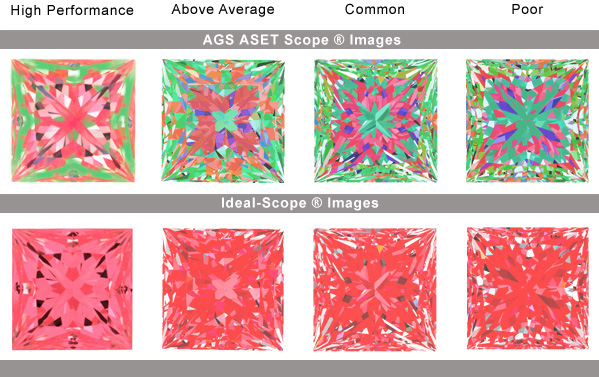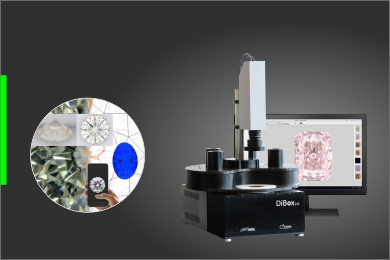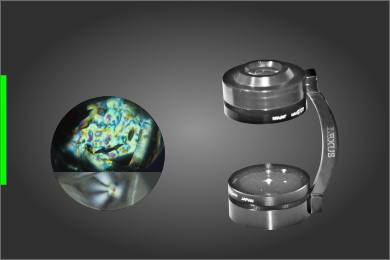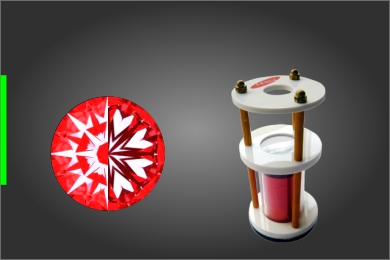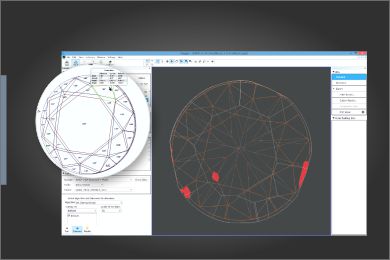AGS Aset Scope
Home Grading & Branding AGS Aset Scope
Education Content : Courtesy of John Pollard. Used with Permission
The "Angular Spectrum Evaluation Tool" is a device that gives the viewer a color-coded map of light usage. This is very important because the quality of light that comes from around and above us is not the same. There are two configurations of the American Gem Society ASET-desktop and handheld.
Light entering a diamond will (a) reflect from the pavilion and return to the viewer’s eye or (b) ‘leak’ through the pavilion.

These performance reflectors, when placed over a diamond, allow a viewer to see where light is returning to the eye and where it is leaking, as well as a “contrast pattern” which is critical to scintillation. Simple to use, both devices do this naturally and effectively. The American Gem Society ASET does reveal more detail, making it preferable for fancy shapes.
The AGSL began cut grading diamonds in 1996, after 30 years of research by the AGS Diamond Grading Standards Committee. Their Angular Spectrum Evaluation Theory or American Gem Society ASET, introduced in 2005, is the foundation of their three-dimensional cut grading system and the AGS Ideal light performance grade.
Here is the hand-held version of the AGS (American Gem Society) ASET,with backlight. The diamond is placed on the backlight and the unit is placed over the diamond.

Light entering the crown is now colour-coded
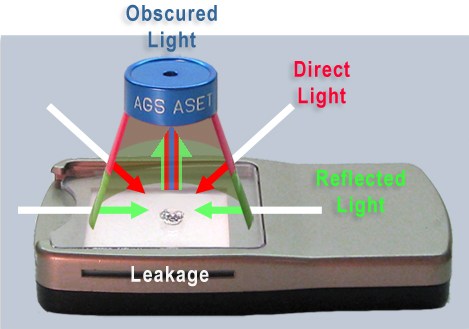
RED is Direct Light (drawn from 45-75 degrees). Red will be the most intense. It comes directly from the source.
GREEN is Reflected Light (drawn from 0-45 degrees). Green has less intensity. It is light reflected from walls, the environment, etc.
BLUE represents light Obscured by the observer (your head blocks this light from reaching the diamond). These areas will light up when the diamond is tilted and other areas will become shaded.
WHITE (if the diamond is backlit, as above) or BLACK (if not) is Leakage These areas show where pavilion facets are acting as windows rather than mirrors. You see white because those windows allow you to look through the diamond and see the light underneath. White should be minimized.
In general RED should be maximized. Some BLUE is necessary. Too much GREEN is undesirable. The distribution of the three colours is important. WHITE should be minimized.
Different Shapes have Different Standards
Each cut has its own set of light performance standards. Fancy cuts are not held to the same standards as Round Brilliants, which are the best at returning an abundance of RED direct light.

High Performance (Rounds)
In high performance rounds RED is dominant, broken by an even BLUE contrast pattern. GREEN is present in small, symmetrical quantities. WHITE leakage should be minimized.
Brightness and Dispersion
Abundant RED indicates abundant light return, which most people find appealing. The balance of dispersion or “fire” seen will depend on the diamond’s configuration or “make.” Large tables and shallow crowns have more whiteness then fire. Small tables and high crowns have more fire than whiteness. Middle combinations are balanced.
Contrast
BLUE creates the contrast pattern in a round diamond. These areas are obscured by the observer in the face-up position. Tilt the diamond slightly and those areas erupt in light as others go dark. Tilt it more and they swap again. Keep tilting and the on-off sparkle you see is scintillation. In high performance diamonds the character of scintillation is influenced by the table and lower halves. Short lower halves result in fewer, broader flashes. Long lower halves create more numerous, smaller flashes. Middle combinations are balanced.

High Performance (Princess Cuts)
In high performance princess cuts RED and GREEN dominate, and the brightest performers have more red. BLUE is present in moderate, even quantities. WHITE (if backlit) or BLACK (if not) may appear but should be minimized.
Brightness and Dispersion
RED rarely reaches the corners in a princess. When it does that edge-to-edge brightness makes the diamond appear larger. Like rounds, abundant RED indicates abundant light return, which most people find appealing. Also like rounds the balance of dispersion or “fire” seen depends on the diamond’s configuration. Large tables and shallow crowns have more whiteness than fire, which is the way most princess cuts are produced (large tables and shallow crowns) since it follows the shape of rough which many cutters find suitable for princess cuts. Designing a middle combination can balance fire and whiteness.
Contrast
RED, GREEN and small areas of BLUE are equally important to the contrast pattern in a princess cut. The pattern is less defined than the round brilliant so princess cuts rely strongly on movement to create the on-off fireworks you see as scintillation. The distribution of colours is extremely important in this shape. WHITE leakage can be present but should be minimized.
Garry Holloway’s Ideal-Scope has been the world’s most widespread performance reflector since the early 2000s. A simpler version of the AGS (American Gem Society) ASET (a precursor by several years) the Ideal-Scope is employed by trade buyers looking to match diamonds quickly as well as numerous internet shoppers and cut enthusiasts. The Ideal-Scope is simple to use and understand and well-suited to judgments in rounds.
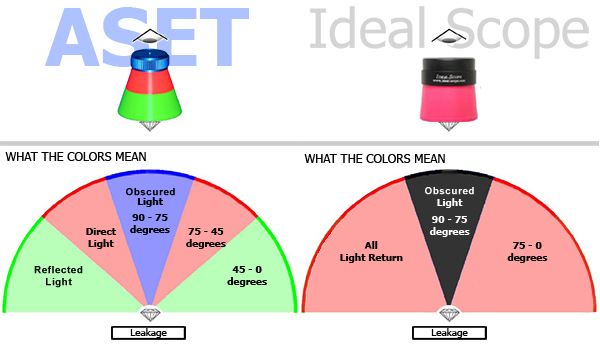
| American Gem Society ASET COLOR CODING | IDEAL-SCOPE COLOR CODING |
|---|---|
| RED: Direct Light, most intensity | RED: All Light Return, Direct & Reflected |
| GREEN: Reflected Light, lesser intensity | (no green, red covers that spectrum) |
| BLUE: Light Obscured by the observer | BLACK: Light Obscured by the observer |
| WHITE (backlit): Leakage | WHITE (backlit): Leakage |
The performance qualities in round brilliants are predominantly direct light (RED in both tools) contrast pattern (BLUE in American Gem Society ASET, BLACK in IS) and leakage (WHITE in both tools) so both tools are well-suited to analyzing rounds.

For fancy shapes the American Gem Society ASET is more suitable for analysis. The Ideal-Scope images below do not show the detailed differences that the American Gem Society ASET does by separating direct light (RED) from reflected light (GREEN).
